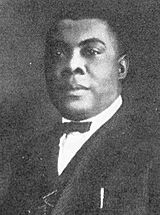George Washington Thomas facts for kids
Quick facts for kids
George Washington Thomas
|
|
|---|---|
 |
|
| Background information | |
| Birth name | George Washington Thomas Jr. |
| Also known as | Gut Bucket George Clay Custer (disputed) |
| Born | March 9, 1883 Plum Bayou Township, Pine Bluff, Arkansas, U.S. |
| Died | March 6, 1937 (aged 53) Chicago, Illinois, U.S. |
| Genres | Jazz, blues, boogie-woogie |
| Occupation(s) | Musician, composer, music publisher |
| Instruments | Piano |
| Years active | c.1900–1930 |
| Associated acts | Clarence Williams Hersal Thomas Sippie Wallace |
George Washington Thomas Jr. (born March 9, 1883 – died March 6, 1937) was an American blues and jazz pianist and songwriter. He was a very important musician who helped create early boogie-woogie piano music. Some of his famous songs include "The New Orleans Hop Scop Blues", "The Fives", and "The Rocks". People think he might have recorded some of his own music using the name Clay Custer.
Contents
Life and Music Career
Early Years in Arkansas and Texas
George W. Thomas Jr. was born in 1883 in Plum Bayou Township, near Pine Bluff, Arkansas. He was one of thirteen children. When he was a teenager, his family moved to Houston, Texas. His father became a deacon at a church there.
George Jr. started playing piano, cornet, and saxophone when he was young. He worked as a pianist in local theaters. His daughter, Hociel Thomas, was born in 1904. His sister, Beulah, later became a famous singer known as Sippie Wallace. Around 1910, George became friends with Clarence Williams, who was also a musician in Houston. They might have even met Jelly Roll Morton, another famous jazz musician, around this time.
Making Music in New Orleans
By 1914, George Thomas and Clarence Williams moved to New Orleans. They started a company to publish their music. George became known as "Gut Bucket George" because of his piano playing at parties.
In 1916, he published "The New Orleans Hop Scop Blues". This song was one of the very first boogie-woogie piano pieces. It had a special left-hand piano part that sounded like a "boogie bass." This song helped George become known as a music publisher and composer.
His younger brother, Hersal Thomas, also joined him in New Orleans. Hersal played George's songs in the Storyville area of the city. He even performed with famous musicians like King Oliver and Louis Armstrong. Another one of George's songs, "Muscle Shoals Blues," was later recorded by well-known pianists like James P. Johnson and Fats Waller.
Moving to Chicago
After his father passed away in 1917, George became the head of his family. When the Storyville area in New Orleans closed down, he moved to Chicago in 1920. His sister Sippie Wallace and brother Hersal also moved to Chicago to perform. George continued to run his music publishing company. He also played with local bands and sang with other musicians, including his sister Sippie. He wrote over 100 songs in his career!
In 1922, George and his brother Hersal wrote "The Fives." This song was inspired by a train ride between Chicago and San Francisco. It was the first published boogie-woogie song that had a "boogie bass line" all the way through. This song helped inspire many other boogie-woogie pianists, like Meade Lux Lewis and Albert Ammons.
The next year, George is believed to have recorded another one of his songs, "The Rocks," for Okeh Records. This recording has one of the earliest examples of a "walking bass" in music. The recording was credited to "Clay Custer," which was probably a made-up name. People still wonder if George Thomas himself played on it, or if it was his brother Hersal, or another pianist.
George Thomas also recorded with other musicians in Chicago. He even had his own jazz group called the Muscle Shoals Devils. George was a respected composer. He once said that people want new and exciting music to dance to. He believed that composers should create original songs, not just copy old ones.
After his brother Hersal sadly passed away in 1926 at only 19 years old, George continued to publish music. However, he wrote fewer songs in the late 1920s. His last recordings were in 1928.
His Passing
For many years, George's sister Sippie Wallace thought he had died around 1930 in a streetcar accident. However, official records show that George Thomas passed away in Chicago in 1937. He died from breaking his back after falling down stairs, possibly during a fire. He was buried in Restvale Cemetery in Alsip, Illinois.
See also
 In Spanish: George W. Thomas para niños
In Spanish: George W. Thomas para niños

